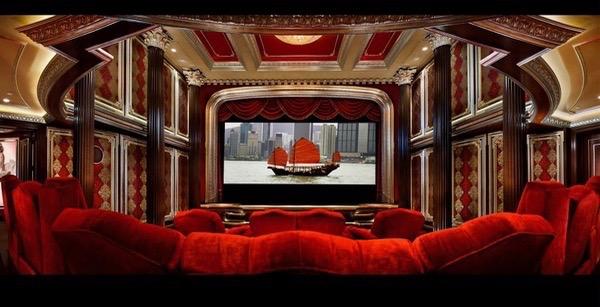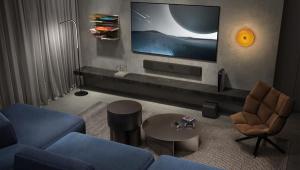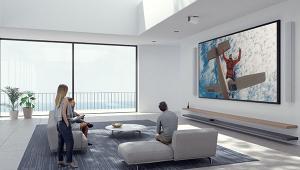Taming the Room Monster

Once you get above a certain frequency, usually between 200 and 500 Hz (known as the Schroeder frequency, after the physicist who first identified it and not the Peanuts character), the room's effect on the sound becomes less significant. Yes, there can still be problems, but they usually involve mid- and high-frequency reflections that can be managed with room treatments, such as absorptive and/or diffusive panels, carpeting, or often just by better arrangement of your soft, fabric upholstered furniture (don't get me started on why I don't like leather seating in a listening space).
Two-channel audiophiles are often the least aware of these room issuesor prefer to ignore them. Yes, many of us (both 2-channel or home theater fans, or those with a foot in both camps) are limited by domestic considerations. But if you're unable to cover at least some of that hardwood or tile floor with a large rug, or cover a wall of glass windows with drapes (at least during serious listening sessions), much of your investment in that pricey audio system is likely going to waste.
But my subject here is largely limited to room issues below 500Hz, which can't be substantially altered by any practical room treatments, at least not those that arrive without divorce papers. Moving the listening position, the speakers (including the subwoofer or subwoofers), or both can often do the trick, but in this the home theater fan is at a serious disadvantage. He or she must also consider where the flat-panel set, or projection screen, will go, and that location is often severely limited. The audio system must then be set up to support the screen and will remain there even when music alone is on the playbill. In my situation the TV (often one that's under review) sits about a foot behind the plane described by the three front speakers and can be pushed a bit further back (and even covered by a small, blanket) for serious audio-only listening. My two retractable, non-perforated projection screens are mounted to the ceiling and can drop down in front of the TV whenever the projector is fired up.
But without further work I still have significant low-frequency room issues. The main speakers sit well out from the bay-shaped walls behind them; they can be moved a little, but not enough to make much of a difference in the bass. I have more flexibility with subwoofer placement, currently with two subs plus their own available adjustments. My listening space itself is fairly average in size, but it's open on one side to other areas of the house so the cubic volume the system must fill is huge. But I do get very satisfying bass. It doesn't "pressurize" the room, but I'm more interested in bass quality than quantity.
My bass problems are primarily above 100Hz, so sub adjustments and sub positioning alone can't completely fix them. Many audiophiles live with these problems, particularly in the two-channel world where equalization is often frowned upon. You can, of course, adapt to these problems and, within limits, learn to ignore them. But when you change speakers constantly, as most reviewers must, that's more difficult. If you're lucky, the bass issues are small and are dips rather than peaks (narrow dips are less audible). But nasty room-generated peaks below 500Hz are all-too common, and can affect your perception of the system as a whole. This can go far beyond my oft repeated comment that a reviewer can tell you what the bass of a speaker under evaluation sounds like in his or her room, but not in yours. Rooms differ in wildly unpredictable ways, and the effect of any room on the bass, unless attended to, will rarely be trivial.
The most common solution, short of a full room make-over and/or rearrangement, is room Eq such as the Audyssey MultEQ XT32 feature available from both my Marantz AV8805 pre-pro and the Denon AVR-X6700H, the latter still in-house from our recent review. Either of them can be used with an optional Audyssey App that allows for a user-set target curve. The Eq can also be limited within the App to under a user-selected frequency such as below 500Hz. The result is then largely restricted to reducing the effects of the room. Such programs are popular and can provide good results. I haven't yet come to full terms with Audyssey, but am still trying from time to time.
I'll always mention any use of Audyssey or other room EQ (such as Dirac Live) in any review. And that applies as well to a more hands-on technique I've used recently. Both the Denon and Marantz mentioned above offer both graphic Eq adjustments and bass and treble tone controls. (Graphic Eq controls have adjustable levels but at fixed frequencies and with a fixed frequency width to their impactthe latter known as the "Q." Parametric controls, which these AVRs don't havemuch as I wish they didoffer adjustable frequencies and adjustable Qs). On the Marantz and Denon the graphic Eq and tone controls are locked out when Audyssey is used, but I've often found them to be effective on their own, at least in my situation.
The catch here is that you can't use the graphic Eq and tone controls effectively by ear. You'll need a measurement program, a microphone, and a mic stand. I use the realistically-priced Omnimic system from Parts Express, but there are others that are neither unreasonably expensive nor require a PhD to operate.
I've often been able to combine the tone controls on the Denon or Marantz with the graphic Eq adjustments (at 63Hz, 125Hz, and 250Hz, mostly the first two), to effectively reduce the bass issues in my system (on the Denon and Marantz the tone controls don't affect the subwoofer, which is a good thing as long as long as the sub or subs are well positioned so they don't produce significant peaks or dips on their own). In my most recent speaker review the results, while not perfect, were far more satisfying than the speakers used au naturel. This won't always work equally well, of course, since a given graphic Eq's frequencies won't always match up perfectly with the offending frequencies, though close enough is often better than no correction at all. Some AVRs, such as the premium Yamahas, have parametric Eqs, and there are outboard parametric Eq devices available for fine tuning a system (mini-DSP is the best known source for the latter). But these options are beyond the scope of this discussion.
Is all of this somehow cheating, particularly in a review? I don't believe so, as long as it's done below the Schroeder frequency, the speakers aren't pushed beyond their obvious bass limits with or without a subwoofer, and the use of this technique is clearly stated in the review. In fact, I prefer to think of any room Eq process (whether via dedicated formats such as Audyssey or as here by using other controls to achieve a properly measured result) as simply giving the speakers a chance to perform their best by putting them in a "better room" without actually moving them! We're correcting for the room's effect on the loudspeakers (an effect which will be different for different speakers and different rooms, including both mine and yours). We're not, in general, correcting the speakers themselves as long as the range above 300-500Hz isn't touched. Going higher in frequency is a different and perhaps defensible activity for the average listener, but it's outside the province of a reviewthough I admit to a weakness for a barely measurable +/-1 dB setting on the treble control, depending on the source material!





























































